Sushi Nozawa (Studio City, CA)
Sushi Nozawa
11288 Ventura Blvd, Los Angeles, CA 91604
818.508.7017
www.sushinozawa.com
Mon 02/20/2012, 08:50p-10:05p

It's the end of an era in LA sushi. On February 29th, Kazunori Nozawa's eponymous Sushi Nozawa closed for good after 25 years of business. Nozawa made a name for himself as much through his authoritarian demeanor as his "Trust Me" omakases, which shunned ridiculous rolls and other such fusion-y things, instead focusing on edomae-style nigiri served on his signature warm, loose rice. Amazingly, I'd never made it out to Nozawa--partly because of the distance, partly because of the horror stories--but I was determined to give the place a shot before it would be gone forever, two-hour wait notwithstanding (there were a whopping 40 people ahead of us in line).
About the Chef: A native of Tokyo, Kazunori Nozawa loved two things growing up: food, and the game of baseball. Nothing came of the latter, however, and the young Nozawa eventually found himself apprenticing at a top sushi restaurant in the City. He spent years mastering every facet of the sushi-making process, from washing dishes to visiting the Tsukiji fish market to cooking rice to actually forming nigirizushi with his own bare hands. He even traveled throughout Japan for five years to learn about the country's vast array of regional specialties. Nozawa returned to Tokyo to work, and soon thereafter, at the age of 30, opened his own successful sushi restaurant. After two years, an opportunity to relocate to the United States popped up, and Nozawa jumped on the chance to move to California.
He started out in Los Angeles at Asuka in Westwood (which is still around), but was appalled at their inauthentic travesty of a menu, par for the course in the 1970's and 1980's. Nozawa aimed to change all that, and began consulting at various restaurants across the country, educating chefs in his Tokyo-style way of sushi. This effort culminated in 1987, when he and his wife Yumiko opened Sushi Nozawa in a tiny strip mall ("Eureka Plaza") in Studio City. The restaurant saw little business in the first few months, but customers began pouring in after a glowing review by Jonathan Gold in the LA Times. The place became a fixture on the LA dining scene, and gave rise to the no-frills, traditional, edomae-influenced sushi joints that dominate the landscape today. It also served as the training ground for a generation of young sushi chefs, including Nobi Kusuhara of Sushi Sasabune fame.
The success of Sushi Nozawa gave the Chef ample opportunity to expand, and in 2006, he partnered with Sona's David Myers to open a Japanese eatery called Sokyo. That restaurant, however, eventually fell through, and instead, Myers debuted Comme Ca in the former Noura Cafe space on La Cienega. Nozawa's big break came in the form of sugarFISH, a casual sushi concept formed in partnership with Sapient co-founder Jerry Greenberg. The first sugarFISH bowed in June 2008 in Marina del Rey, with a Brentwood outpost appearing a year later. This was followed up by a sugarFISH Downtown in October 2010, and a Santa Monica shop in January 2011 (in the old Taka Sushi spot). The restaurants are doing quite well, and there are rumors of locations opening up in West Hollywood and even Corona del Mar. In fact, Sushi Nozawa itself will be transformed into a sugarFISH after the end of February.

Inside, things are cramped and perhaps a touch garish. The omakase-only sushi bar seats nine, while twice the number fit into half a dozen tables. Annoyingly, no reservations are taken.
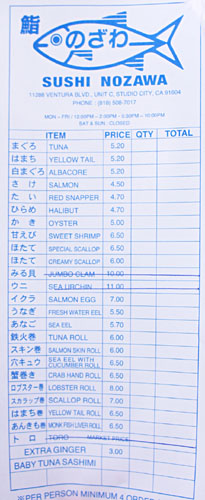
Sushi Nozawa's menu doesn't stray too far from the norm, presenting just your basic neta--no izaki or shima aji here, that's for sure. I was surprised at the large number of temaki hand rolls offered however. Though most diners opt to get the omakase (which runs in the neighborhood of $60pp), we made it a point to order everything on the menu à la carte (minus the items that they ran out of). Click for a larger version.
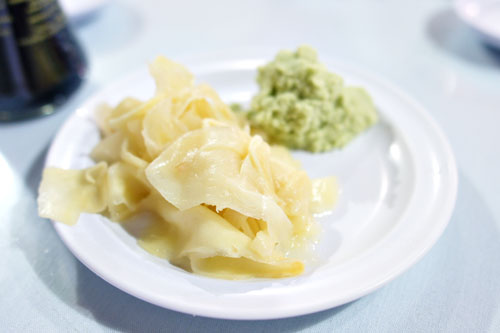
A big plate of gari and wasabi (real, I believe) to split amongst the table. Extra ginger? An additional three bucks.
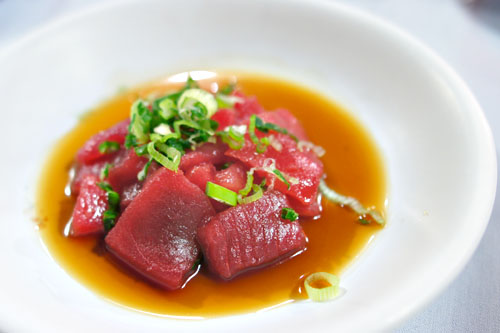
Baby Tuna Sashimi [$16.00]
We began with the restaurant's signature starter, a sashimi of baby tuna. It was a satisfying way to start the meal, with the supple, substantial cuts of akami pairing in classic fashion with its accoutrements of tangy, countervailing scallion and ponzu.

Yellow Tail [$5.20]
Hamachi was just as expected, soft and somewhat fatty. A pretty prototypical presentation of yellowtail.
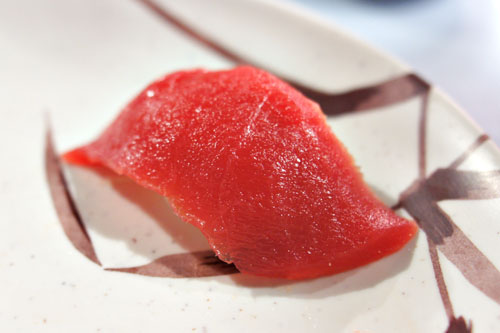
Tuna [$5.20]
Tuna was nice, with a tender bite and a somewhat milder flavor than the sashimi presented earlier.
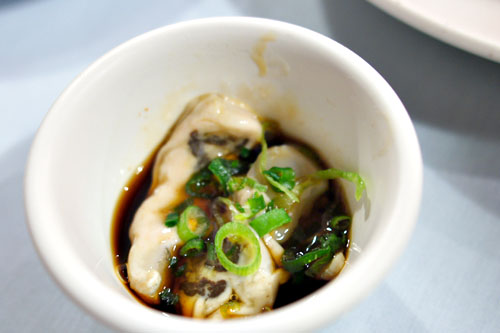
Oyster [$5.00]
Two kaki one cup. We weren't told what kind of oysters these were, but they were certainly enjoyable: sweet and saline all at the same time, with a lovely counterpoint from the tangy ponzu and negi.
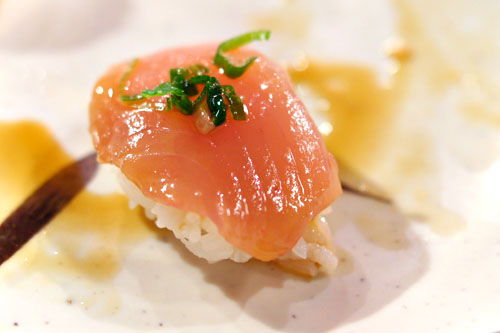
Albacore [$5.20]
It was certainly nice to encounter albacore served completely raw instead of seared. Think soft and slippery, with a artful accent from the topping of scallion.
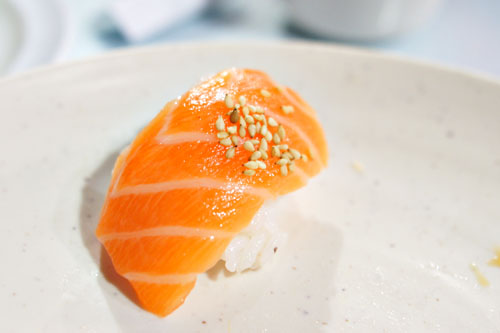
Salmon [$4.50]
Salmon was lovely: lush, creamy, and fresh, with a delightful nuttiness courtesy of a sprinkle of sesame seeds.

Sweet Shrimp [$6.50]
I'd never had sweet shrimp quite like this before. It seemed almost cooked in consistency, which really threw me off. I wasn't sure what to think. And no deep-fried heads?
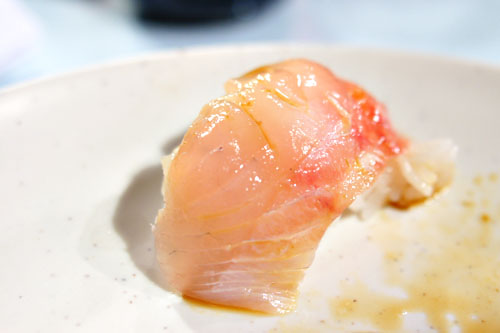
Red Snapper [$4.70]
Snapper was probably one of my favorites of the meal. It was spot on texturally, and I thoroughly enjoyed the citrus-y component here.
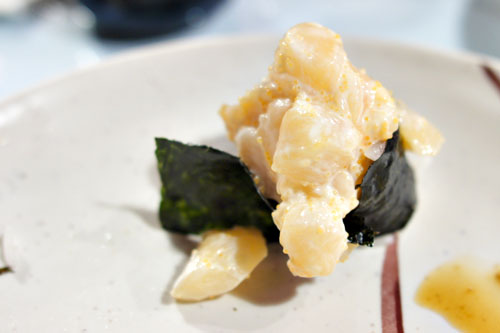
Creamy Scallop [$6.00]
The so-called "creamy" scallop reminded me of my early days of sushi. The mayo-like sauce that the hotate were bathed in did mask some of their natural flavor, but the dish still worked out just fine, with the creaminess of the scallops playing along well with the seaweed wrapper.
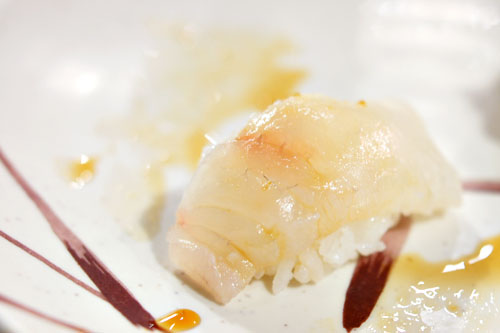
Halibut [$4.70]
Halibut was nice as well, with a medium body and fairly mild flavor, adroitly amped up by the piquant smack of what I believe was yuzukosho (a condiment of chili, yuzu, and salt).
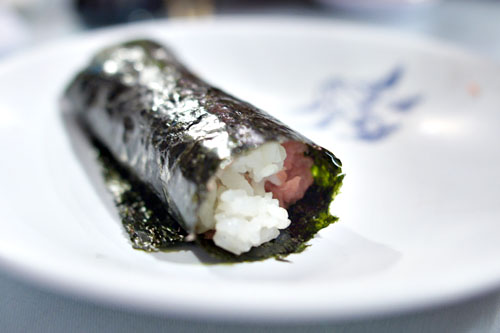
Tuna Roll [$6.00]
Time to kick off our gauntlet of temaki. The tuna roll was tasty enough, with a good interplay between the fish and its nori wrapper, but I would've liked some scallions in here to mix things up (in effect making it a negitoromaki).
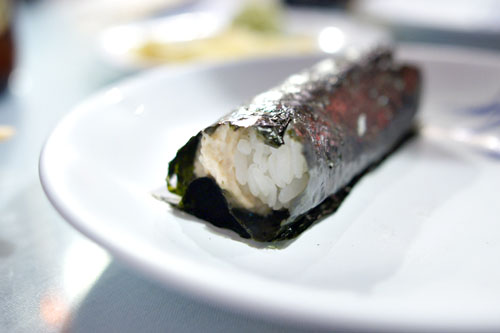
Crab Hand Roll [$6.50]
Next up was Nozawa's signature blue crab hand roll, often imitated, often duplicated. I really enjoyed it, with the sweet, ocean-y relish of the kani at the forefront of the dish, joined by a delightful temperature contrast between the warm rice and cool crab.
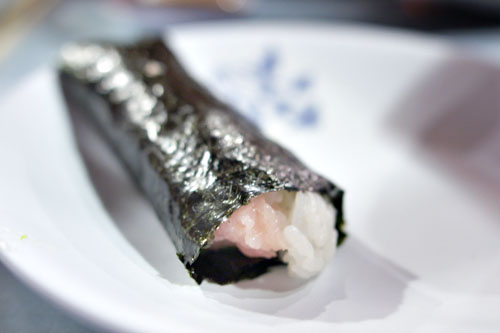
Yellow Tail Roll [$6.50]
The yellowtail roll was surprisingly delicious, with a great combination of flavors between the fatty fish and tangy scallions.
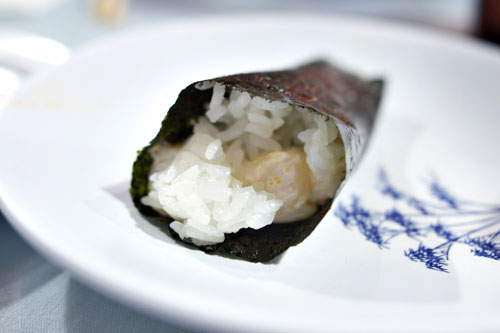
Scallop Roll [$7.00]
I didn't mind this next roll either, with a dab of soy sauce complementing the creamy, warm scallops wonderfully.
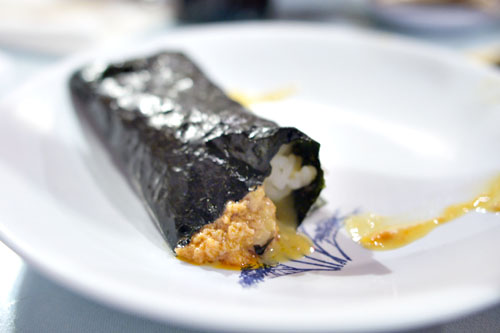
Monk Fish Liver Roll [$6.50]
The ankimo temaki, unfortunately, was probably the weakest of the bunch. The liver itself didn't have much character, and was dominated by the dish's sweet, tart sauce, while its runny, gooey texture wasn't to my liking either.

Fresh Water Eel [$5.50]
Moving back to the nigiri now, unagi was textbook: fatty, soft, and sweet, with a nice topping of goma.
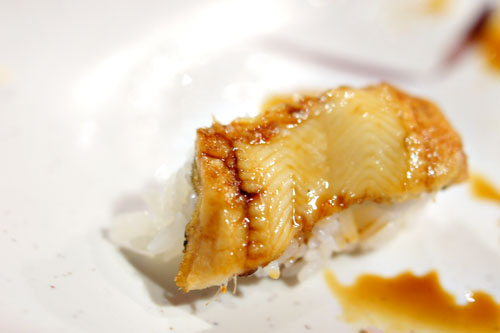
Sea Eel [$5.70]
I think I actually preferred the anago, which was leaner in texture with more savory, complex flavors.
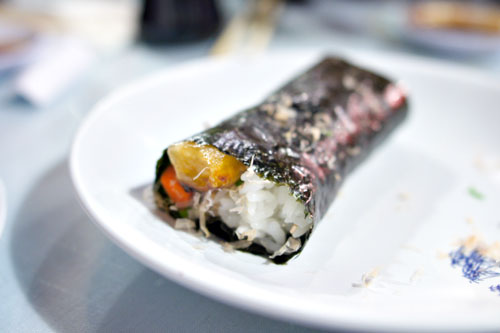
Salmon Skin Roll [$6.00]
The salmon skin roll was pretty awesome, with its crunchy "stick" of fatty, fishy goodness perfectly balanced by the inclusion of pickles, all while the rice and seaweed grounded and tempered the dish.
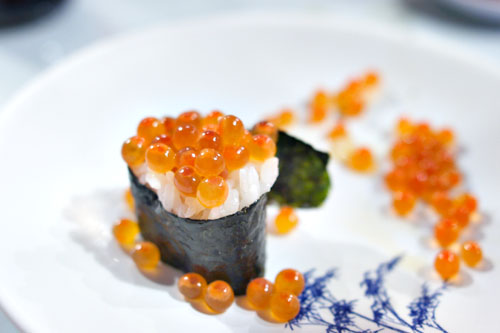
Salmon Egg [$7.00]
Ikura, meanwhile, was good but not outstanding (and somewhat sloppily constructed), with nice pinpoints of brine from the gamboge globules.
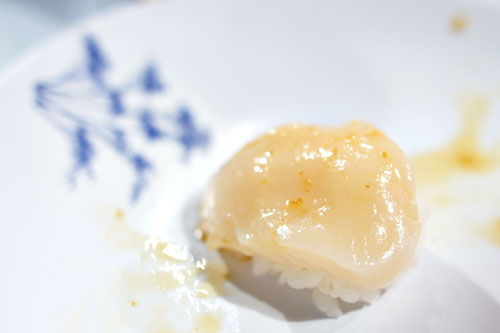
Special Scallop [$6.50]
Now this is the type of scallop that I'm talking about: creamy and sweet, with a subtle salinity and a beautiful contrast in the form of a dab of yuzukosho.
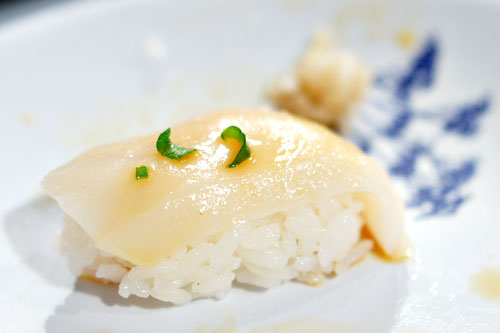
Black Cod [$5.50]
The final nigirizushi of the night was actually an off-menu special, usually only offered to those dining omakase (thanks to the couple next to us for the tip!). Gindara is actually really hard to find in sushi form, so this was a pleasant surprise. I'd had it only once before, at Ohshima in Orange, where it was amazing. This version wasn't quite as revelatory, though it was still tasty, with a simultaneously lush, yet firm consistency and a delicate flavor, accented by just a touch of tangy ponzu.

Lobster Roll [$8.00]
Our server managed to forget our lobster hand rolls, so that's why they came out last. They were worth the wait though. I loved the sheer sweet decadence of the meat here (even more so than the crab), and how everything just melded together flawlessly. A fitting conclusion to the meal.
There is no doubt that Nozawa is an icon, a game changer, a fixture on the scene that influenced scores of sushi restaurants that followed. In that regard, we should be thankful. As for the food itself, I had no real complaints. It was some solid sushi to be sure--tasty, fresh, and satisfying, but at the same time, not in the same league as a Mori, Zo, or even Nozomi (and let's not even start on Urasawa). I can definitely see why people like the place, but for me, the experience could definitely use a bit of work. The pacing was just far, far too rushed (22 courses in 1¼ hours), and the whole operation seemed assembly-line. In the end, none of this really matters, since the place is closing, but I'm glad that I finally got to experience the master, the legend, the Sushi Nazi firsthand.
11288 Ventura Blvd, Los Angeles, CA 91604
818.508.7017
www.sushinozawa.com
Mon 02/20/2012, 08:50p-10:05p

It's the end of an era in LA sushi. On February 29th, Kazunori Nozawa's eponymous Sushi Nozawa closed for good after 25 years of business. Nozawa made a name for himself as much through his authoritarian demeanor as his "Trust Me" omakases, which shunned ridiculous rolls and other such fusion-y things, instead focusing on edomae-style nigiri served on his signature warm, loose rice. Amazingly, I'd never made it out to Nozawa--partly because of the distance, partly because of the horror stories--but I was determined to give the place a shot before it would be gone forever, two-hour wait notwithstanding (there were a whopping 40 people ahead of us in line).
About the Chef: A native of Tokyo, Kazunori Nozawa loved two things growing up: food, and the game of baseball. Nothing came of the latter, however, and the young Nozawa eventually found himself apprenticing at a top sushi restaurant in the City. He spent years mastering every facet of the sushi-making process, from washing dishes to visiting the Tsukiji fish market to cooking rice to actually forming nigirizushi with his own bare hands. He even traveled throughout Japan for five years to learn about the country's vast array of regional specialties. Nozawa returned to Tokyo to work, and soon thereafter, at the age of 30, opened his own successful sushi restaurant. After two years, an opportunity to relocate to the United States popped up, and Nozawa jumped on the chance to move to California.
He started out in Los Angeles at Asuka in Westwood (which is still around), but was appalled at their inauthentic travesty of a menu, par for the course in the 1970's and 1980's. Nozawa aimed to change all that, and began consulting at various restaurants across the country, educating chefs in his Tokyo-style way of sushi. This effort culminated in 1987, when he and his wife Yumiko opened Sushi Nozawa in a tiny strip mall ("Eureka Plaza") in Studio City. The restaurant saw little business in the first few months, but customers began pouring in after a glowing review by Jonathan Gold in the LA Times. The place became a fixture on the LA dining scene, and gave rise to the no-frills, traditional, edomae-influenced sushi joints that dominate the landscape today. It also served as the training ground for a generation of young sushi chefs, including Nobi Kusuhara of Sushi Sasabune fame.
The success of Sushi Nozawa gave the Chef ample opportunity to expand, and in 2006, he partnered with Sona's David Myers to open a Japanese eatery called Sokyo. That restaurant, however, eventually fell through, and instead, Myers debuted Comme Ca in the former Noura Cafe space on La Cienega. Nozawa's big break came in the form of sugarFISH, a casual sushi concept formed in partnership with Sapient co-founder Jerry Greenberg. The first sugarFISH bowed in June 2008 in Marina del Rey, with a Brentwood outpost appearing a year later. This was followed up by a sugarFISH Downtown in October 2010, and a Santa Monica shop in January 2011 (in the old Taka Sushi spot). The restaurants are doing quite well, and there are rumors of locations opening up in West Hollywood and even Corona del Mar. In fact, Sushi Nozawa itself will be transformed into a sugarFISH after the end of February.

Inside, things are cramped and perhaps a touch garish. The omakase-only sushi bar seats nine, while twice the number fit into half a dozen tables. Annoyingly, no reservations are taken.

Sushi Nozawa's menu doesn't stray too far from the norm, presenting just your basic neta--no izaki or shima aji here, that's for sure. I was surprised at the large number of temaki hand rolls offered however. Though most diners opt to get the omakase (which runs in the neighborhood of $60pp), we made it a point to order everything on the menu à la carte (minus the items that they ran out of). Click for a larger version.

A big plate of gari and wasabi (real, I believe) to split amongst the table. Extra ginger? An additional three bucks.

Baby Tuna Sashimi [$16.00]
We began with the restaurant's signature starter, a sashimi of baby tuna. It was a satisfying way to start the meal, with the supple, substantial cuts of akami pairing in classic fashion with its accoutrements of tangy, countervailing scallion and ponzu.

Yellow Tail [$5.20]
Hamachi was just as expected, soft and somewhat fatty. A pretty prototypical presentation of yellowtail.

Tuna [$5.20]
Tuna was nice, with a tender bite and a somewhat milder flavor than the sashimi presented earlier.

Oyster [$5.00]
Two kaki one cup. We weren't told what kind of oysters these were, but they were certainly enjoyable: sweet and saline all at the same time, with a lovely counterpoint from the tangy ponzu and negi.

Albacore [$5.20]
It was certainly nice to encounter albacore served completely raw instead of seared. Think soft and slippery, with a artful accent from the topping of scallion.

Salmon [$4.50]
Salmon was lovely: lush, creamy, and fresh, with a delightful nuttiness courtesy of a sprinkle of sesame seeds.

Sweet Shrimp [$6.50]
I'd never had sweet shrimp quite like this before. It seemed almost cooked in consistency, which really threw me off. I wasn't sure what to think. And no deep-fried heads?

Red Snapper [$4.70]
Snapper was probably one of my favorites of the meal. It was spot on texturally, and I thoroughly enjoyed the citrus-y component here.

Creamy Scallop [$6.00]
The so-called "creamy" scallop reminded me of my early days of sushi. The mayo-like sauce that the hotate were bathed in did mask some of their natural flavor, but the dish still worked out just fine, with the creaminess of the scallops playing along well with the seaweed wrapper.

Halibut [$4.70]
Halibut was nice as well, with a medium body and fairly mild flavor, adroitly amped up by the piquant smack of what I believe was yuzukosho (a condiment of chili, yuzu, and salt).

Tuna Roll [$6.00]
Time to kick off our gauntlet of temaki. The tuna roll was tasty enough, with a good interplay between the fish and its nori wrapper, but I would've liked some scallions in here to mix things up (in effect making it a negitoromaki).

Crab Hand Roll [$6.50]
Next up was Nozawa's signature blue crab hand roll, often imitated, often duplicated. I really enjoyed it, with the sweet, ocean-y relish of the kani at the forefront of the dish, joined by a delightful temperature contrast between the warm rice and cool crab.

Yellow Tail Roll [$6.50]
The yellowtail roll was surprisingly delicious, with a great combination of flavors between the fatty fish and tangy scallions.

Scallop Roll [$7.00]
I didn't mind this next roll either, with a dab of soy sauce complementing the creamy, warm scallops wonderfully.

Monk Fish Liver Roll [$6.50]
The ankimo temaki, unfortunately, was probably the weakest of the bunch. The liver itself didn't have much character, and was dominated by the dish's sweet, tart sauce, while its runny, gooey texture wasn't to my liking either.

Fresh Water Eel [$5.50]
Moving back to the nigiri now, unagi was textbook: fatty, soft, and sweet, with a nice topping of goma.

Sea Eel [$5.70]
I think I actually preferred the anago, which was leaner in texture with more savory, complex flavors.

Salmon Skin Roll [$6.00]
The salmon skin roll was pretty awesome, with its crunchy "stick" of fatty, fishy goodness perfectly balanced by the inclusion of pickles, all while the rice and seaweed grounded and tempered the dish.

Salmon Egg [$7.00]
Ikura, meanwhile, was good but not outstanding (and somewhat sloppily constructed), with nice pinpoints of brine from the gamboge globules.

Special Scallop [$6.50]
Now this is the type of scallop that I'm talking about: creamy and sweet, with a subtle salinity and a beautiful contrast in the form of a dab of yuzukosho.

Black Cod [$5.50]
The final nigirizushi of the night was actually an off-menu special, usually only offered to those dining omakase (thanks to the couple next to us for the tip!). Gindara is actually really hard to find in sushi form, so this was a pleasant surprise. I'd had it only once before, at Ohshima in Orange, where it was amazing. This version wasn't quite as revelatory, though it was still tasty, with a simultaneously lush, yet firm consistency and a delicate flavor, accented by just a touch of tangy ponzu.

Lobster Roll [$8.00]
Our server managed to forget our lobster hand rolls, so that's why they came out last. They were worth the wait though. I loved the sheer sweet decadence of the meat here (even more so than the crab), and how everything just melded together flawlessly. A fitting conclusion to the meal.
There is no doubt that Nozawa is an icon, a game changer, a fixture on the scene that influenced scores of sushi restaurants that followed. In that regard, we should be thankful. As for the food itself, I had no real complaints. It was some solid sushi to be sure--tasty, fresh, and satisfying, but at the same time, not in the same league as a Mori, Zo, or even Nozomi (and let's not even start on Urasawa). I can definitely see why people like the place, but for me, the experience could definitely use a bit of work. The pacing was just far, far too rushed (22 courses in 1¼ hours), and the whole operation seemed assembly-line. In the end, none of this really matters, since the place is closing, but I'm glad that I finally got to experience the master, the legend, the Sushi Nazi firsthand.
12 Comments:
Thanks for this post. Glad you finally made it out there. I liked the perspective since it's so easy to compare Nozawa to the fine sushi places nowadays, it seems that you tried to put imagine what it was like twenty-five years ago when there was not much quite like it. It may be the end of a pioneering restaurant, but it's certainly not the end of an era. Nozawa's hand in changing the landscape of LA sushi lives on in every high-end sushi restaurant now.
I think if it felt rushed, it may be because a zillion people were waiting in line to get their last taste of nozawa.
It's unfortunate that you didn't get to experience Nozawa 20-25 years ago, in its hey day. It was definitely not an assembly-line type production back then. There was only Nozawa himself behind the bar. There was no wait (I can remember being there when the place was typically only half-full) for a seat. Food came out at a more leisurely pace. And the sushi quality was unlike anything else being served on Ventura Blvd.
I was unable to make another visit before he closed, but maybe I'm better off remembering the experience as it was, rather than what it became
Kevin,
How does it compare to the fare at Sugarfish, both quality and pricewise? Would you say Sugarfish is still the best bang for your buck, sushiwise, around?
Best,
Dan
Love your blog for over 2 years! Can you recommend an outstanding sushi place in San Francisco?
Thanks
ASUKA- MEH.
I do like SugarFISH. Can't comment on Nozawa.
Just about 25-30% of the food cost .........Tell me you are rich !
For Jack in SF - Sushi Sam's in San Mateo.
Aaron: A valid point Aaron. It's the end of Nozawa, but you're right, his legacy definitely lives on.
pinguino: I don't think so. From everything I've heard, it's always been a rush at Nozawa, at least for the past several years.
Jack: It is unfortunate indeed. It would've been great to see the Nozawa of the 1980's and early 1990's, the Nozawa that inspired that Jonathan Gold pieces in the Times.
Dan: It's actually pretty similar to sugarFISH in terms of quality, but at double the cost, so the latter is definitely a better value. As for bang-for-the-buck, I mentioned Nozomi and Ohshima earlier, but they're definitely on the higher end. At the $35-ish price range, I think you might as well stick to sugarFISH.
Jack: Unfortunately I actually haven't had sushi in SF yet. Sawa seems to be the place to go up in the Bay Area though.
Amy: Not surprised at the "meh." I don't think Asuka's ever been all that good.
Anon: Care to elaborate there?
Anon: Thanks for the rec.
Ever been to Wa? (http://www.yelp.com/biz/wa-sushi-and-bistro-west-hollywood-2)
I've not been to Wa. Any good?
Haven't been for 2 years now. Was excellent back then but 1 or 2 of the Yelp reviews mention the quality has gone down. Will be back in LA in July so will see then. You should give it a go. Wouldn't mind seeing a review of it before I go back :).
Post a Comment
Subscribe to Post Comments [Atom]
<< Home